Cross-Selling Predictive Analytics: Insights You Can’t Ignore
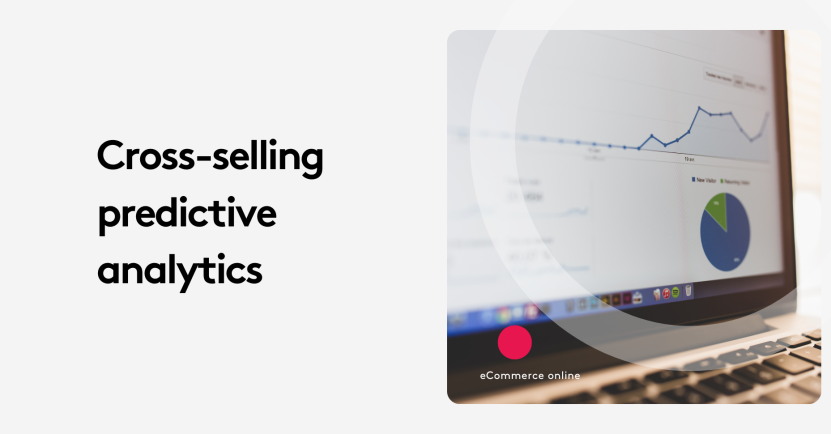
Harnessing cross-selling predictive analytics can transform your sales strategy by revealing hidden customer patterns. Discover why companies leveraging these insights gain a competitive edge others often miss.
More specifically, it’s to continue making an increased amount of sales while investing less and less time, money and energy into the process of doing so.
At first, this might seem like a monumental task: How are you supposed to increase your customer base - and sell more to your existing customers - without putting extra effort into your sales initiatives?
Not to worry. As is the case in many other areas of your business, technology has your back.
In this article, we’ll discuss how you can implement predictive analytics into your email marketing campaigns to develop and deliver highly-targeted content and offers to your prospects and customers - in turn increasing their propensity to buy (and to buy more) from your eCommerce store.
Before we dive in, though, let’s hammer out the basics of what predictive analytics actually is, as well as why using it in conjunction with email marketing can be so effective.
Key takeaways
- Predictive analytics enhances email marketing by using past customer data to create highly targeted, personalized content that increases sales and engagement.
- It helps acquire new customers by analyzing both explicit data (form inputs) and implicit behaviors (website activity) to deliver relevant, segmented welcome emails.
- For current customers, predictive analytics enables smarter upselling and cross-selling through timely, personalized offers based on browsing, purchase, and cart abandonment behavior.
- Predictive analytics supports customer retention by identifying at-risk customers through behavioral patterns, allowing marketers to send automated, targeted emails to prevent churn.
On this page:
What is predictive analytics?
Even if you’ve heard of predictive analytics in the past, you may not exactly be sure what it is, or why it can be so beneficial to your marketing initiatives.
Essentially, predictive analytics is a process in which a piece of software analyzes previously-collected data regarding past consumers’ decisions and behaviors to determine what, exactly, gets them to take a specific action (such as engaging further with the company in question or making a purchase from its store).
Once the software better understands the various characteristics and behaviors (and motivators of such behaviors) of your target consumers, it then segments them accordingly.
After the software has defined a given customer or prospect as belonging to a specific segment, your marketing team will be in prime position to send them laser-focused offers and other content via email that will almost certainly lead to further engagement. While your team will still have to put effort into creating such tailored content and offers, they won’t have to spend near as much time determining who, exactly, will benefit from receiving them.
"Predictive analytics is going to play an increasingly important part of marketing in the very near future…(but) the creative side is still a way off. Predictive analytics will help you understand patterns, but you’re still going to need real people to leverage those patterns with compelling copy, eye catching images, and out of the box strategy ideas. Predictive analytics is simply going to take all the hassle out of research, so you can spend more time devising smarter tactics.”
- Pete Boyle, Founder of PJBoyle.com
But, why email marketing?
One more point to clarify before we move on is the reason we’re looking at the use of predictive analytics specifically within the realm of email marketing.
The simple fact is, email marketing is the most effective means of engaging with your current and prospective customers.
Case in point:
- 81% of marketers say email is the best way to acquire customers in the first place
- 80% of marketers say it’s the best method for keeping customers on board
- Email marketing generates an average of $44 for every $1 spent on a given campaign
All this being said, though, it’s not an absolute certainty that your email marketing initiatives will be successful. For this to happen, your campaigns must be relevant, timely and tailored according to a given customer’s expectations.
There was once a time that marketing tools used to be quite expensive, and only mostly for very large or enterprise companies, however, these days, a marketer can find a cheap email newsletter service that either has all the tools insider or can do great integrations.
With that in mind, then, it’s rather obvious that predictive analytics can be hugely beneficial when used in conjunction with your email marketing initiatives.
So, without further ado, let’s dive into how, exactly, you can do so.
Using predictive analytics to sell smarter via email
As we’ve alluded to thus far, predictive analytics can help you improve your ability to acquire customers, improve your customer retention rate, and increase your overall customer lifetime value.
Additionally, though setting up predictive analytics software may initially cost your company a decent amount of time and money, it will ultimately allow you to streamline the process of collecting the data necessary to optimize your marketing campaigns. As Pete Boyle explained above, since you won’t need to spend excess time collecting and making sense of your customer-facing data, you’ll be able to focus your energy on actually doing something with the data you’ve collected.
“As your audience grows, your messaging to customers will become less personalized. The more you invest in using predictive analytics to sell via email, the more you can personalize messages to customers on a massive scale.”
- Sophia Le, Email Persuasion Engineer
Here, we’ll explain just how to use predictive analytics for each of these initiatives, providing examples of how companies have successfully done so in the past.
Let’s get started.
Acquiring customers through predictive analytics
There’s no sugarcoating it:
Marketing to brand new prospects is much more difficult than marketing to current customers and longtime fans of your brand.
This, of course, is mainly due to the fact that you know little to nothing about these individuals.
As we said earlier, though: predictive analytics has you covered.
In addition to analyzing the information new prospects actively share with your company (via mailing list subscription form, for example), predictive analytics software also takes into consideration the more “behind the scenes” data regarding the actions a prospect takes when visiting your site. This data might include the specific web pages of your site the prospect visited before signing up or the referring site from which the prospect found your company.
“This ‘behind the scenes’ data would provide lead scoring, lead segmentation for campaign nurturing, and targeted content distribution better understanding on the Lifetime Value Prediction. When a campaign has this true measurement of marketing ROI, acquiring future customers should become less challenging.”
- Jennifer Xue, Digital Strategist
The point of collecting all this data as early as possible is to be able to send a more personalized (and hopefully more targeted) welcome email to new customers or subscribers.
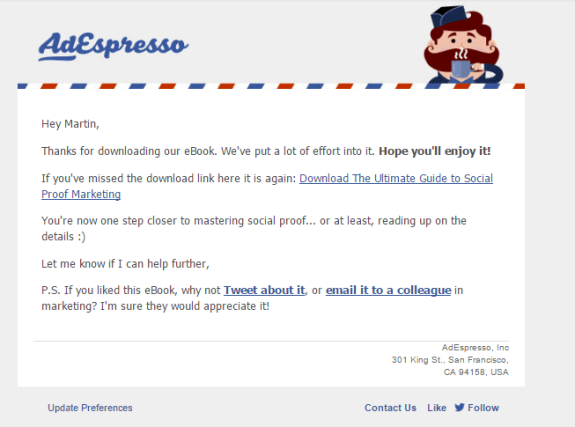
In the example above, AdEspresso simply chose to personalize the greeting for its initial email to new followers. Presumably, the company also segmented its new subscribers based on which ebook or other offer attracted them to the brand in the first place - at which point the company’s marketing team could then send more targeted offers in the future.
“When you send relevant (aka targeted) emails, it positions you as the obvious solution to your customers’ problem. Being relevant is vital to being successful in this saturated world of hyper-marketing. It cuts through the noise, helping your customer zero in on your solution.”
- Laura Lopuch, Email Conversion Engineer
But it’s also possible to actually use your welcome email itself to further segment your new prospects via predictive analytics. For example, take a look at the following welcome email from REI Co-Op:
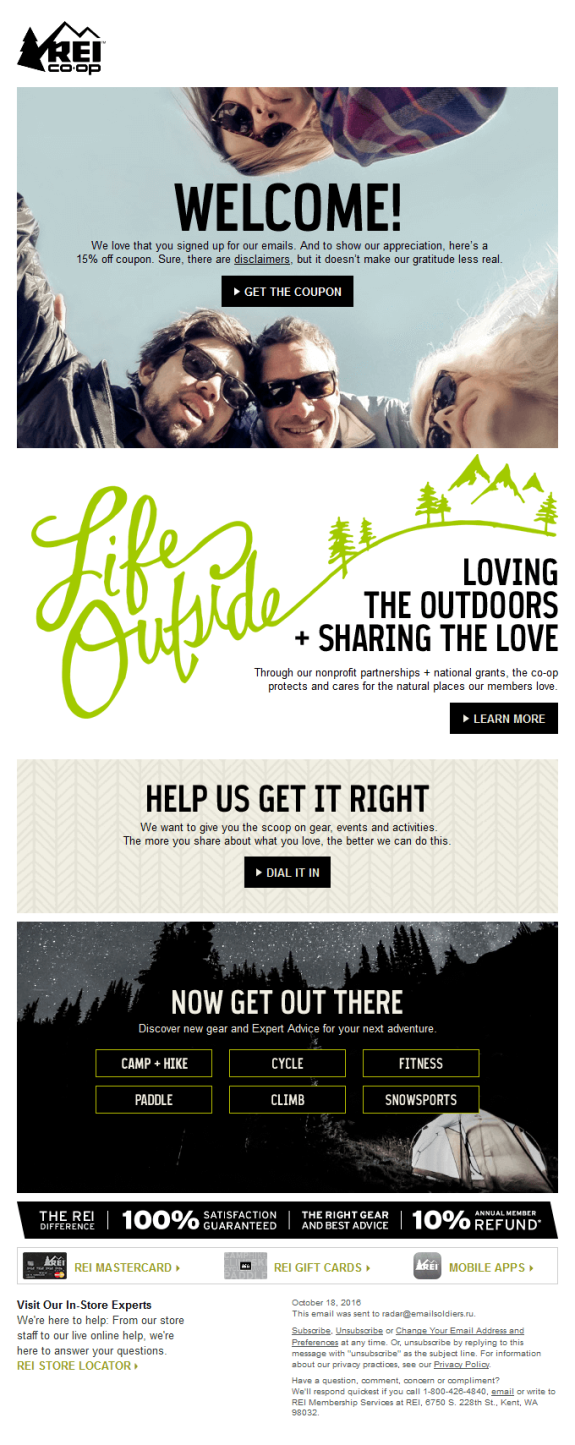
Notice the section in the screenshot above titled “Help Us Get It Right”? Rather than be rather covert in its attempt to gain more info on its new prospects, REI simply asks them straight out to tell the company what type of content they want to receive. Here would be a perfect situation in which the use of predictive analytics would easily enable the marketing team to send targeted content to new subscribers, as they could be placed into various segments depending upon their expressed preferences.
Additionally, REI also provides new followers with the option of clicking on one of six activities of interest, such as camping and snowsports. Again, depending on which category the new prospect clicks on, REI could use predictive analytics to segment them accordingly and begin sending them discounts and offers for products related specifically to that activity.
As you probably know from experience, acquiring new customers isn’t exactly easy. However, by using predictive analytics to immediately begin collecting data on your potential customers - and using this data to provide them with highly-targeted offers - your conversion rate will almost assuredly improve.
Using predictive analytics to sell more to current customers
As we’ve discussed before, the only thing better than making a sale is making multiple sales in a single transaction.
Using predictive analytics, you can easily and strategically offer upsells and cross-sells to those who have previously made purchases from your online store.
With regard to upselling through your eCommerce store, you essentially have two options:
- Offer a more valuable product if the customer has yet to make a purchase (i.e., has navigated away from your site without converting)
- Offer a more valuable product after a designated amount of time has passed
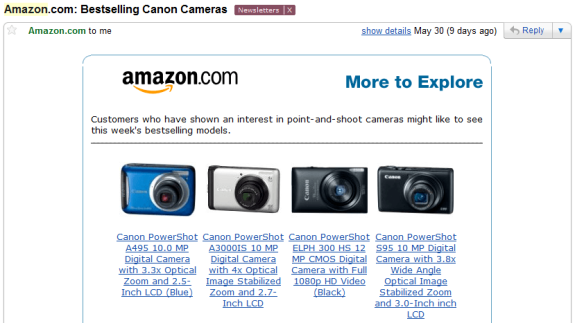
In the example above, Amazon used predictive analytics to note that the customer had been browsing the site for a new camera, but had yet to make a decision. Rather than simply sitting back and hoping the customer returns to make a purchase, Amazon sends an email presenting a number of similar products for them to choose from.
Predictive analytics can also help you identify those who have purchased previous versions of a newly-upgraded or updated product, and reach out to them accordingly.
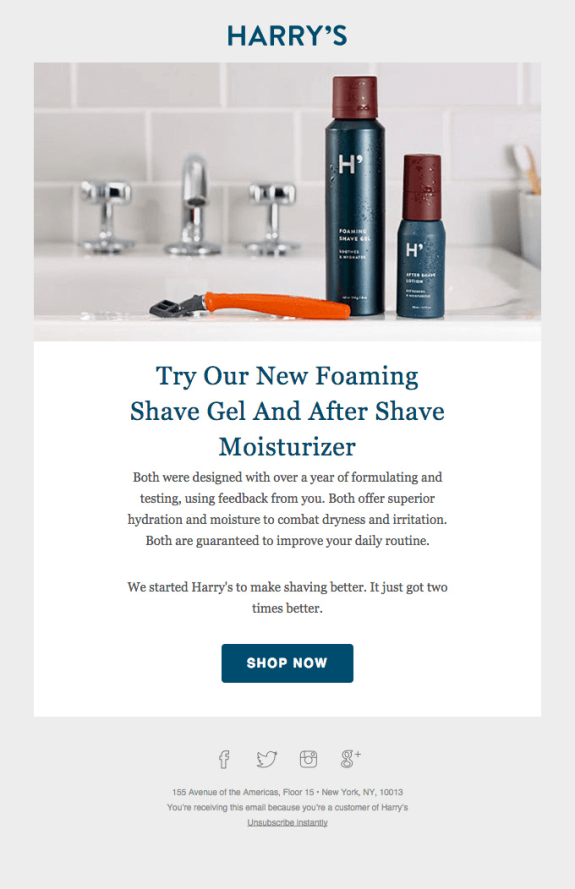
In contrast to using predictive analytics to upsell to your customers (which requires you to “play the long game”), you can use the same technology to immediately offer cross-sells to those who have recently made a purchase from your store, too.
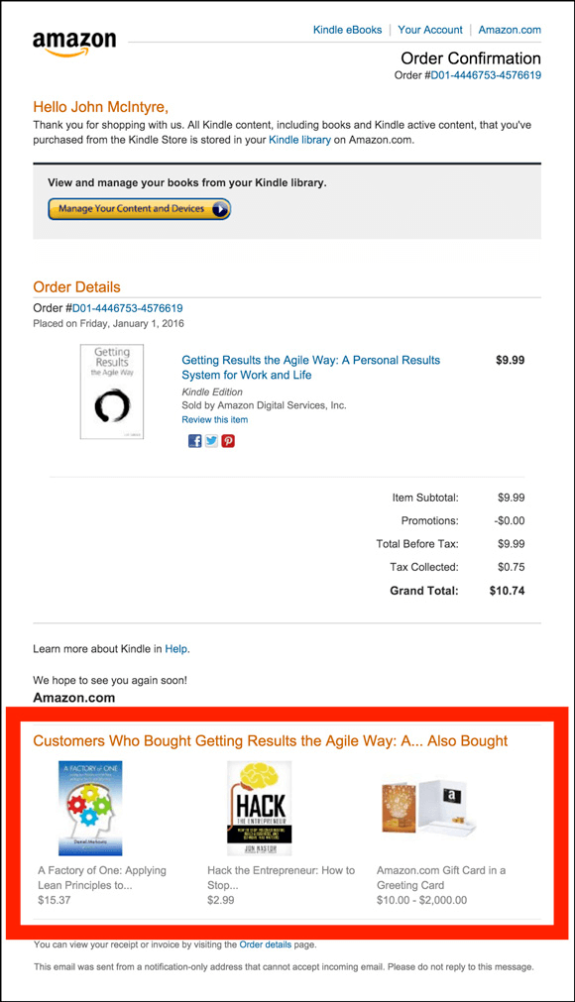
Again, eCommerce giant Amazon provides a perfect example of how to use predictive analytics in conjunction with email marketing, this time focusing on cross-selling.
Greg d'Aboville, Head of Growth at WisePops, vouches personally for Amazon’s use of predictive analytics to make upsells and cross-sells:
"When I started working at Amazon, I was amazed by the click-through-rate and the conversion rate of the emails we sent. We generated as much revenue with an email sent to 10,000 users as with an email sent to 200,000 users in the company I was working at prior to Amazon. By analyzing the categories the user visited, the products they viewed, (and) the items they added to cart and abandoned, Amazon's algorithms were able to determine quite precisely what the user would buy next."
One thing to note, here, is that the items being cross-sold meet two criteria: they are items that customers who purchased the initial item also purchased, and they are items that relate in some way to the initial item, as well.
You can also use predictive analytics to...predict...when a given customer will need to reorder a consumable product.
For example, if you sell beauty products via your eCommerce store, it’s likely that some of your customers purchase the same face soap around the same time each month (give or take a few days). Using predictive analytics to analyze both an individual’s purchasing patterns, as well as the patterns of all customers who purchase that same product, you can easily pinpoint the optimum moment to remind customers via email that it’s about time to make their monthly purchase.
Now, it’s not always a given that a customer will make a purchase every time they visit your eCommerce store. And, as is often the case, there will be times when your customers load up their virtual shopping cart but end up navigating away from your site before going through with a purchase.
In such instances, predictive analytics can help you determine the best way to reach out to these “cart abandoners” to get them back on track toward making a purchase. This might mean sending an email reminder at just the right time (e.g., 24-48 hours after their last visit), or providing a discount along with your reminder email. Rather than sending the same offer, after the same amount of time, to all cart abandoners, you can use predictive analytics to determine the best offer - and the optimal timing to send this offer - to each individual customer.
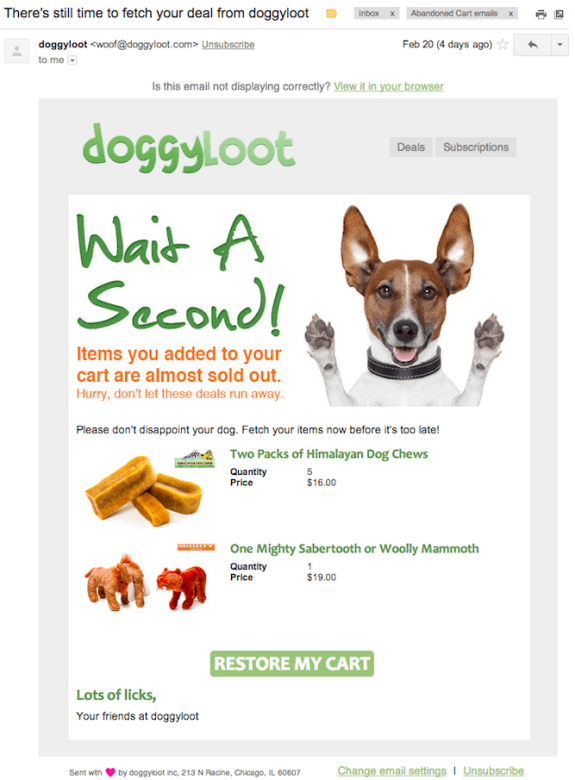
As we said earlier, the less time, money, and energy you need to put into making additional sales, the better off your company will be. Predictive analytics takes most of the guesswork out of the process of determining the right offers for the right customers and allows you to deliver these offers with relative ease.
Keeping customers on board via predictive analytics
While keeping current customers on board is universally said to be easier than acquiring new ones, it’s still not exactly easy to do.
Once more, predictive analytics can make the whole process that much easier.
As we mentioned earlier, predictive analytics helps marketing teams determine the shopping patterns of both individual customers and customer segments as a whole.
In this same way, predictive analytics software can analyze the pre-defection actions taken by customers who have churned and uses this data to identify other customers who are at risk of churning (or weaning off of their normal purchase routine, as the case may be). The marketing team can then develop email messages to be automatically delivered to customers who exhibit such at-risk behavior in the future.
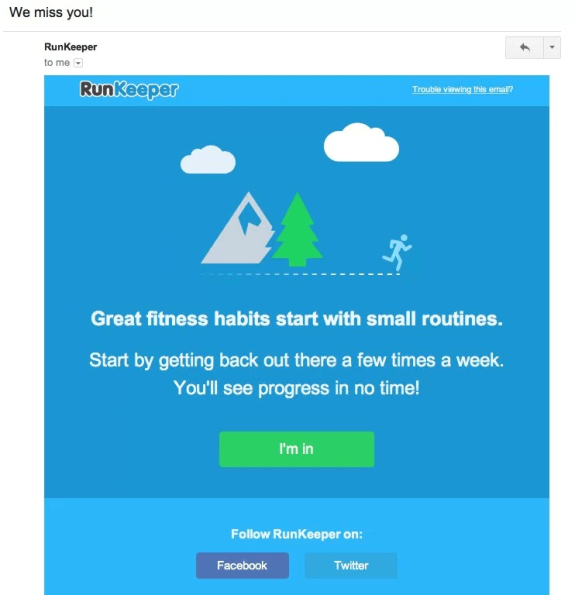
On the other side of the spectrum, predictive analytics can also help companies solidify their relationship with loyal customers, as well.
In the same way that the software can identify behaviors that are indicative of potential churn, it can also identify actions taken by customers as they’re about to ramp up the amount of business they do with the company in question. This allows the marketing team to shoot these soon-to-be-loyal customers an email regarding loyalty or VIP programs at the exact right moment (as opposed to sending these messages way too early in the relationship and coming off as pushy or desperate).
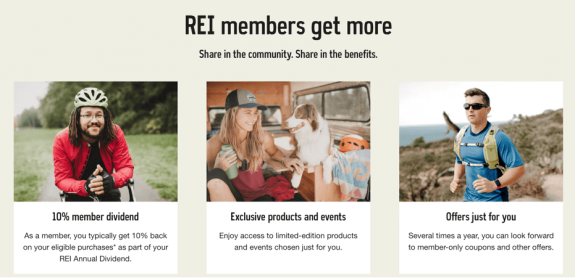
Lastly, predictive analytics can help companies determine when loyal customers are most likely to go a step further and recommend the brand to their friends.
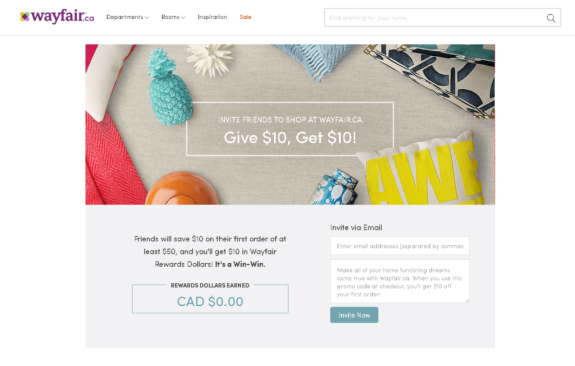
Again, sending such an email before a customer is ready to make an honest referral could end up backfiring (or, at the very least, end up falling on deaf ears). With predictive analytics, though, marketing teams will gain a better understanding of where the “evangelism threshold” is (e.g., most loyal customers tend to make referrals after x amount of purchases or x amount of time spent as a customer).
Whether you’re looking to keep at-risk customers from churning or to strengthen your relationship with your long-standing customers, predictive analytics can help you determine the exact right time to send out a perfectly-tailored email to help you accomplish your goals.
Wrapping up
Despite our complexity, we human beings tend to be rather predictable when it comes to our habits as consumers.
Still, it’s incredibly tough to manually predict a given customer’s future actions based on their current or past behavior - especially if their behavior doesn’t seem to be out of the ordinary to the naked eye.
Predictive analytics, then, enables you to metaphorically examine your customers’ actions under a microscope and to scrutinize even their most innocuous-seeming behaviors to determine what their next move will likely be with regard to your company. In turn, you can develop and deliver laser-focused messages via email right when your customers are most likely to engage with them.













